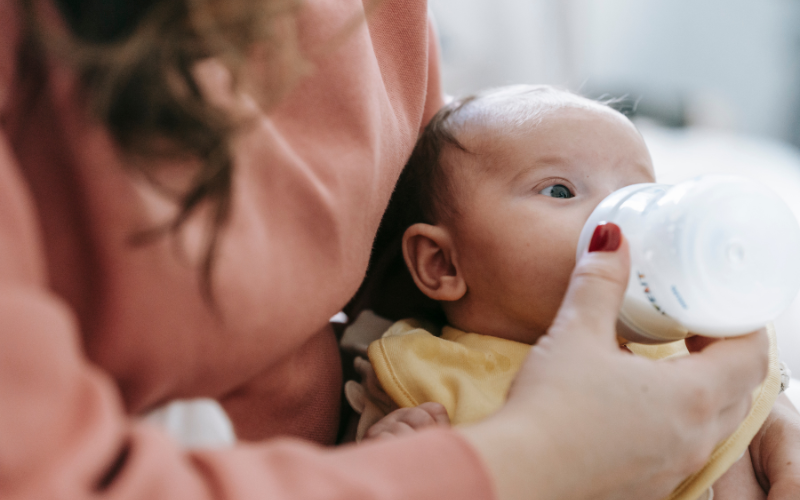-
Due Date Calculator.

-
What are The Most Common Methods for Calculating Pregnancy?

-
Calculating Your Due Date Using Ultrasound

-
Calculating Your Due Date from Your Last Menstrual Period (LMP)

-
Calculating Your due date by The Date of Conception

-
Calculating Your Due Date from IVF

-
How Do You Measure Gestational and Fetal Age?

-
Planning Your Due Date and Planning for Changes

-
FAQs

Pregnancy Due Date Calculator
Discover tips and methods for calculating your due date, including using your menstrual cycle, conception date, IVF, and ultrasound. Use our calculator to determine your due date! (add this before the calculator).
Written by: Nurture&'s team.
Medically reviewed by Gabriela Alvarado.
Medical Doctor from the Central University of Venezuela. She holds certifications in Public Health Practice from institutions such as Johns Hopkins University (USA) and Imperial College London (UK).
From the moment a parent sees a positive pregnancy test, the calculations on when the baby will arrive immediately begin! A visit with your healthcare provider and an ultrasound scan are some of the most accurate ways to determine a baby’s due date. However, there are different tests, methods, and factors that one can use to figure out their estimated date of delivery, , including using an American pregnancy calculator.
If you are expecting a baby, this article will give you tips on establishing your pregnancy due date. Read on to discover everything you need to know about calculating the date of your baby’s arrival.
What are The Most Common Methods for Calculating Pregnancy?
There are four common methods for calculating pregnancy: calculating the due date using ultrasound, estimating based on the first day of the last menstrual period (LMP), determining by the date of conception, and calculating from the embryo transfer date in cases of IVF.
These methods ensure accurate monitoring of pregnancy progression and preparation for childbirth. Whichever method suits your situation, you can utilize the Nurture& Pregnancy Calculator.
Calculating Your Due Date Using Ultrasound
Ultrasounds are part of routine obstetrics care. The American College of Obstetricians and Gynecologists states that an ultrasound during the first trimester is not standard prenatal care, but it’s often used to determine:
Gestational age
The number of fetuses
Fetal heart rate
To screen for genetic disorders
To check for ectopic pregnancy
A second-trimester ultrasound is conducted between weeks 18-22 and will confirm gestational age, scan for abnormalities, check the amniotic fluid level, and estimate your baby’s length and weight.
Estimate your due date using the Nurture& Pregnancy Calculator located at the top of this page.
Calculating Your Due Date from Your Last Menstrual Period (LMP)
Using your menstrual cycle to figure out your estimated due date (EDD) is quite simple! You can apply these rules:
Naegele’s Rule
All you need to do is add 280 days from the start of your last menstrual period (LMP). This is referred to as Naegele’s Rule and assumes a 28-day cycle. However, suppose your cycle length varies or is longer or shorter than the average length. In that case, this method may not provide an accurate date.
Mittendorf-Williams Rule
Another due date calculator that uses the menstrual cycle is the Mittendorf-Williams rule. However, this method is slightly more complicated.
Determine the start date of your last menstrual cycle.
Count back three months from that date.
Add 15 days to that new date for a first pregnancy or 10 days if it is a subsequent pregnancy.
To keep things simple, estimate your due date by using the Nurture& Pregnancy Calculator at the top of this page.
Pregnancy Wheel
To use a pregnancy wheel, first locate the first day of your last menstrual period (LMP) on the outer wheel. Then, rotate the inner wheel to align this date with the marker on the outer wheel, usually labeled "LMP" or "First Day of Last Period." Once aligned, find the estimated due date on the outer wheel, which corresponds to the "Due Date" marker on the inner wheel.
The pregnancy wheel will also show other important milestones, such as the end of the first trimester (around 12 weeks) and the second trimester (around 28 weeks).
To simplify, estimate your due date using the Nurture& Pregnancy Calculator located at the top of this page, avoiding the need to purchase or print the wheel.

Calculating Your Due Date by The Date of Conception
Calculating your baby’s ETA by the date of conception is slightly more complicated than using your cycle. If you know the date of conception and have a regular cycle, you can add 266 days to that date.
However, the date of fertilization is challenging to pin down and almost impossible to determine. Sperm can live in the body for up to five days, and once ovulation occurs, the egg lives up to twenty hours after release.
Many women, particularly those not trying to conceive, do not even realize they are pregnant until several weeks of pregnancy have passed.
To keep things simple, estimate your due date using the Nurture& Pregnancy Due Date Calculator at the top of this page.
Calculating Your Due Date from IVF
IVF or in vitro fertilization is an assisted reproductive procedure. During IVF, the mother will undergo egg retrieval, and the eggs will be fertilized in a lab. Once fertilized, one or more embryos will be implanted into the uterus.
Calculating your date by conception is more accurate when parents use in vitro fertilization because your doctor will know the exact date of fertilization.
How Do You Measure Gestational and Fetal Age?
Two standard methods of measuring a baby’s age during pregnancy are gestational age and fetal age.
Gestational Age
Gestation is the time that passes between conception and birth. To measure the gestational age of your baby, you count the number of days between your last menstrual period and the current date. The gestational age measures how many weeks pregnant you are.
You can calculate gestational age in several ways: ultrasound scan, clinical examination, hCG hormone test, or embryo transfer in the case of IVF. If you’ve undergone IVF, you can determine your baby’s gestational age by counting from your transfer date.
Fetal Age
On the other hand, fetal age is the age of your growing baby. It is calculated from the date of conception, which is roughly two to three weeks after the first day of your last menstrual period.
Planning Your Due Date and Planning for Changes
If you are trying to get pregnant, you can attempt to plan your due date for a specific season or time of year. However, there is no way to guarantee when or if you will conceive or when your baby will be born. Very few full-term pregnancies deliver on their estimated date; only 4%!
It is also possible that your due date can change as your pregnancy progresses. This is most likely to occur if you did not have a first-trimester ultrasound. It may also change if your doctor notices your fundal height is abnormal or that your levels of alpha-fetoprotein are high, a sign your baby will be born soon.
The best advice is to expect your baby to arrive a little early or late and give the most accurate health information possible to your provider so they can estimate your due date.
No matter when your baby is expected, having the time frame narrowed down to a few weeks will help you prepare. You will have plenty of time to set up your nursery, complete with Nurture& seating and furniture, a play pad, and comfy pillows.
If you’re attempting to become pregnant or have recently discovered you are pregnant, you can use these tips to calculate your due date and prepare for all the exciting milestones to come!
FAQs
What is The Most Accurate Method of Pregnancy Calculation?
The most accurate method of pregnancy calculation typically involves using ultrasound scans to measure fetal size and development. This method provides precise information about gestational age and due dates. Alternatively, calculating from the first day of the last menstrual period (LMP) and accounting for the regularity of menstrual cycles can also yield reliable estimates. Factors such as the timing of conception and the individual's menstrual cycle length contribute to the accuracy of these calculations.
For the most precise results, consulting with a healthcare provider and utilizing tools like our Nurture& Pregnancy Calculator can help ensure accurate pregnancy tracking and planning.
Can my due date change?
Yes, due dates can change based on ultrasound measurements and other medical assessments during pregnancy. Healthcare providers may adjust the due date if fetal development indicates a different timeframe than originally estimated.
How Can I Calculate Pregnancy Weeks by LMP?
Calculating pregnancy weeks by LMP involves determining the first day of your Last Menstrual Period (LMP) and counting the weeks from that date to the current day. Typically, pregnancy lasts around 40 weeks from the LMP, and you can estimate your due date by adding 40 weeks to the LMP date.
Using our pregnancy calculator can simplify this process, but for precise information, consulting your healthcare provider is recommended, as they can provide accurate estimates based on ultrasounds and other prenatal measurements.
What is The EDD Calculator Formula Using LMP?
The Estimated Due Date (EDD) can be calculated by adding 280 days (40 weeks) to the first day of your LMP. This is referred to as Naegele’s Rule and assumes a 28-day cycle.
To keep things simple, estimate your due date by using the Nurture& Pregnancy Calculator at the top of this page.
How to Calculate EDD Manually?
Manually calculate your EDD (Estimated Due Date) by adding 7 days to the first day of your LMP, then subtracting 3 months, and adding 1 year.
Estimate your due date effortlessly using the Nurture& Pregnancy Calculator situated at the top of this page.
Can Pregnancy Calculators Account For Irregular Menstrual Cycles?
Yes, advanced pregnancy calculators can accommodate irregular menstrual cycles by allowing users to input their average cycle length or the length of their last few cycles. This helps in providing more accurate estimations of gestational age and due dates.
How to Count Pregnancy After Missed Period?
Pregnancy is typically counted from the first day of your last menstrual period (LMP). If you've missed a period, you can estimate your pregnancy duration by adding the number of weeks since your missed period to the LMP date.
When Did I Conceive If I Don't Remember My Last Period?
If you're unsure about your LMP, an ultrasound scan can provide a more accurate estimation of your conception date based on fetal size and development.
Is There a Difference Between Gestational Age and Fetal Age?
Yes, there is a difference between gestational age and fetal age. Gestational age refers to the age of the pregnancy counted from the first day of the last menstrual period (LMP). Fetal age, on the other hand, is the actual age of the fetus since conception. Gestational age is typically used in medical contexts and when discussing pregnancy milestones.
What Factors Can Affect The accuracy Of Pregnancy Calculators?
Several factors can impact the accuracy of pregnancy calculators, including irregular menstrual cycles, variations in cycle length, incorrect LMP dates, and variations in ovulation timing. Additionally, factors such as medical conditions affecting pregnancy or variations in fetal growth can also affect the precision of calculations. Using reliable data and tools, like our Nurture& Pregnancy Calculator, can help mitigate these factors for more accurate results.
Can I plan my due date?
While you can estimate your due date based on your last menstrual period (LMP) or conception date, the actual timing of birth can vary. Planning around your estimated due date helps prepare for childbirth, but the exact day of delivery is influenced by various factors.
How soon can I take a pregnancy test?
Most pregnancy tests can detect pregnancy hormones (hCG) in urine as early as the first day of a missed period. Some tests claim to detect pregnancy even earlier, but for the most accurate results, it's recommended to wait until after you've missed a period.
Related articles:
Guides for Setting Up Your Baby's Nursery:
Sources:
For the due date calculator, the editorial team of Nuture& relied on various reputable sources to ensure accuracy and reliability.
National Library of Medicine: Naegele's Rule, also known as Naegele's Formula or Naegele's Law, is a simple method used to estimate the expected due date of a pregnant woman. It was developed by the German obstetrician Franz Karl Naegele in the early 19th century.
National Library of Medicine: Mittendorf-Williams Rule, also known as Mittendorf-Williams Estimated Fetal Weight (EFW) formula, is a method used to estimate the weight of a fetus during pregnancy. It was developed by Dr. Robert Mittendorf and Dr. William D. Williams in 1990 as an alternative to other methods for estimating fetal weight, such as the Johnson-Toshach formula.
American College of Obstetricians and Gynecologists: Methods for Estimating the Due Date
American College of Obstetricians and Gynecologists: Ultrasound exams
Mayo Clinic: In vitro Fertilization
Nurture& was born out of a desire to create thoughtfully designed and premium quality nursery & kids products for modern parents. We’re here so that you can focus on your number one priority - making the beautiful big moments with your family and soaking in all the little ones in between.


















